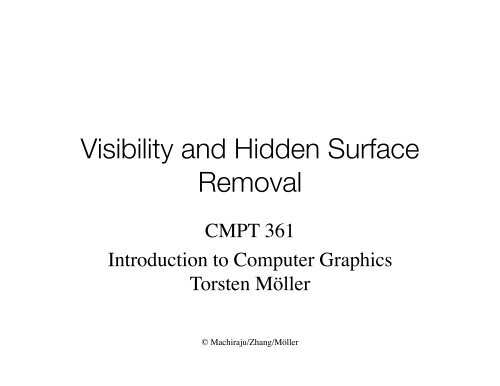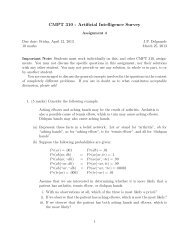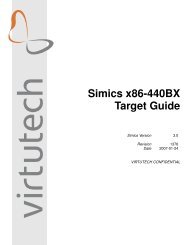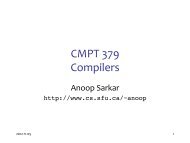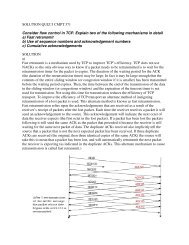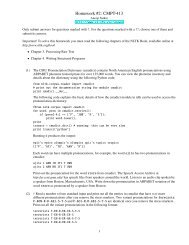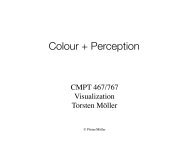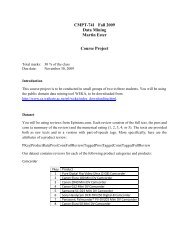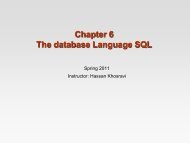Visibility and Hidden Surface Removal
Visibility and Hidden Surface Removal
Visibility and Hidden Surface Removal
You also want an ePaper? Increase the reach of your titles
YUMPU automatically turns print PDFs into web optimized ePapers that Google loves.
<strong>Visibility</strong> <strong>and</strong> <strong>Hidden</strong> <strong>Surface</strong><br />
<strong>Removal</strong><br />
CMPT 361<br />
Introduction to Computer Graphics<br />
Torsten Möller<br />
© Machiraju/Zhang/Möller
Rendering Pipeline<br />
Hardware<br />
Modelling Transform <strong>Visibility</strong><br />
Illumination +<br />
Shading<br />
Perception,<br />
Interaction<br />
© Machiraju/Zhang/Möller<br />
Color<br />
Texture/<br />
Realism
Reading<br />
• Angel – Chapter 6.10-6.11, 8.11<br />
• Foley et al – Chapter 15<br />
• Shirley+Marschner – Chapter 12<br />
© Machiraju/Zhang/Möller<br />
3
<strong>Visibility</strong><br />
• Polygonal model - a collection of vertices<br />
© Machiraju/Zhang/Möller<br />
4
<strong>Visibility</strong> (2)<br />
• Connecting dots (wireframe) helps,<br />
• but it is still ambiguous<br />
© Machiraju/Zhang/Möller<br />
5
<strong>Visibility</strong> (3)<br />
• <strong>Visibility</strong> helps to resolve this ambiguity<br />
© Machiraju/Zhang/Möller<br />
6
<strong>Visibility</strong> (4)<br />
• Include shading for a better sense of 3D<br />
© Machiraju/Zhang/Möller<br />
7
<strong>Visibility</strong> (5)<br />
• Another Example<br />
© Machiraju/Zhang/Möller<br />
8
<strong>Visibility</strong> (6)<br />
• wireframe<br />
© Machiraju/Zhang/Möller<br />
9
<strong>Visibility</strong> (7)<br />
• Inner object visibility<br />
Back-Face Culling<br />
© Machiraju/Zhang/Möller<br />
10
<strong>Visibility</strong> (8)<br />
• Inter-object visibility<br />
© Machiraju/Zhang/Möller<br />
11
<strong>Visibility</strong> (9)<br />
• Shading<br />
© Machiraju/Zhang/Möller<br />
12
Why compute visibility?<br />
• Realism: Occlusions make scenes look more<br />
realistic<br />
• Less ambiguity: <strong>Visibility</strong> computations<br />
provide us with depth perception<br />
• Efficiency: Rendering is time consuming, so<br />
we should not have to waste time on objects<br />
we cannot see © Machiraju/Zhang/Möller<br />
13
<strong>Visibility</strong> + shading<br />
• <strong>Visibility</strong> is only one aspect for realistic<br />
rendering<br />
• <strong>Visibility</strong> + shading → even better sense of<br />
3D<br />
© Machiraju/Zhang/Möller<br />
14
Classification of algorithms<br />
• <strong>Hidden</strong> surface removal (HSR) vs. visible surface<br />
determination (VSD)<br />
– HSR: figure out what cannot be seen<br />
– VSD: figure out what can be seen<br />
• Image space vs. object space algorithms<br />
– Image space: per pixel based (image precision) ―<br />
determine color of pixel based on what is visible,<br />
e.g., ray tracing, z-buffering<br />
– Object space: per polygon or object based in object<br />
space (object precision), eg, back to front (depth sort)<br />
– In many cases a hybrid of the two is used<br />
© Machiraju/Zhang/Möller<br />
15
Image Space<br />
For each pixel in image {<br />
determine the object closest to the<br />
viewer, pierced by the projector<br />
through the pixel<br />
draw the pixel using the appropriate<br />
colour<br />
}<br />
• dependent on image resolution<br />
• simpler, possibly cheaper<br />
• aliasing a factor<br />
© Machiraju/Zhang/Möller
Object Space<br />
for each object in world {<br />
determine those parts of objects<br />
whose view is unobstructed by<br />
other parts of it or other objects<br />
draw those parts in the appropriate<br />
colour<br />
}<br />
• independent of image resolution<br />
• More complex 3D interactions<br />
• Can be more expensive, e.g., subdivision<br />
• designed first for vector displays<br />
© Machiraju/Zhang/Möller
<strong>Visibility</strong> is expensive<br />
• Image space – brute-force<br />
– O( #pixels * #objects)<br />
– 1286 x 1024 resolution <strong>and</strong> 1 million polygons<br />
– Complexity: O(1.3 x 10 12 )<br />
• Object space – brute-force<br />
– Worst-case: each object compared with the<br />
others<br />
– Complexity: O(n 2 ), e.g., 1 million polygons →<br />
O(10 12 )<br />
© Machiraju/Zhang/Möller<br />
18
How to improve efficiency<br />
• Pay attention to order in which primitives<br />
are processed, e.g., if back to front then just<br />
“paint”<br />
• Be as lazy as possible!<br />
– Costly operations are to be avoided as much as<br />
possible, e.g., use of bounding boxes<br />
– Try to make use of previous computations, e.g.,<br />
utilize coherence<br />
• Specifically …<br />
© Machiraju/Zhang/Möller<br />
19
Efficient visibility techniques<br />
• Coherence<br />
• Use of projection normalization<br />
• Bounding boxes or extents<br />
• Back-face culling<br />
• Spatial partitioning or spatial subdivision<br />
• Hierarchy<br />
© Machiraju/Zhang/Möller<br />
20
1. Coherence<br />
• Why? — Object properties, e.g.,<br />
– geometry, color, shading, <strong>and</strong><br />
– visibility situations<br />
often vary smoothly – local similarities<br />
• Utilizing coherence: reuse computations<br />
made for one part of an object for nearby<br />
parts<br />
– without change or<br />
– with only incremental updates<br />
© Machiraju/Zhang/Möller<br />
21
1. Object <strong>and</strong> area coherence<br />
• Object coherence<br />
– if two objects are well separated,<br />
only one comparison is needed<br />
between objects <strong>and</strong> not between<br />
their component faces<br />
• Area coherence:<br />
– group of adjacent pixels likely<br />
covered by the same visible face<br />
© Machiraju/Zhang/Möller<br />
22
1. Edge <strong>and</strong> face coherence<br />
• Edge coherence<br />
– an edge changes visibility only where it crosses a visible<br />
edge or when it penetrates a visible face<br />
• Implied edge:<br />
– line of intersection of two planar faces can be determined<br />
from two intersection points<br />
• Scan-line coherence<br />
– visibility information will likely change little between<br />
adjacent scan lines<br />
• Face coherence<br />
– <strong>Surface</strong> properties will likely vary smoothly across a face,<br />
so calculations on © a Machiraju/Zhang/Möller<br />
face may be modified incrementally<br />
23
1. Depth <strong>and</strong> frame coherence<br />
• Depth coherence<br />
– once the depth of one surface point is<br />
computed, the depth of the rest of the surface<br />
can be found from a difference equation (e.g.,<br />
in z-buffer) – adjacent parts of a face have<br />
similar depth values<br />
• Frame coherence<br />
– images in a sequence (e.g., animation) will<br />
likely change little from one to the other, so can<br />
reuse information from current frame – key to<br />
© Machiraju/Zhang/Möller<br />
compression 24
2. Use of projection<br />
normalization<br />
• Want to determine whether point P 1<br />
obscures P2<br />
• Need to see whether two points are on the<br />
same projector<br />
• With our projection<br />
normalization, just<br />
need to check the x<br />
<strong>and</strong> y’s of P’ 1 <strong>and</strong> P’ 2<br />
© Machiraju/Zhang/Möller<br />
25
2. Perspective Transform<br />
• Parallel projection - just check (x,y) values<br />
(need canonical volume!)<br />
• perspective - more work!<br />
• need to check if<br />
x 1 /z 1 = x 2 /z 2 <strong>and</strong><br />
y 1 /z 1 = y 2 /z 2 .<br />
© Machiraju/Zhang/Möller<br />
26
2. Perspective Transform<br />
• Can bring canonical view-volume into<br />
screen coordinates<br />
© Machiraju/Zhang/Möller
3. Bounding Objects<br />
• Operations with objects are expensive!<br />
• Can we do a quick test with an<br />
approximation of the object?<br />
• Answer - yes!<br />
• Technique - approximation through<br />
“bounding volumes” or “extents”<br />
• avoid unnecessary clipping<br />
avoid unnecessary comparisons between<br />
objects or their projections<br />
© Machiraju/Zhang/Möller<br />
28
3. Bounding Objects (2)<br />
• For rendering of projected polygons. If<br />
extents do not overlap, neither should the<br />
polygons<br />
© Machiraju/Zhang/Möller<br />
29
3. Bounding Objects (3)<br />
• If the extents overlap then either one of the<br />
following cases will apply<br />
• Typically further subdivision<br />
© Machiraju/Zhang/Möller<br />
30
3. Bounding Objects (4)<br />
• rectangular extents => bounding boxes, or<br />
bounding volumes in 3D<br />
– in general there are many possible bounding<br />
boxes<br />
– want to choose one that is efficient for a<br />
particular application (i.e. axis-aligned)<br />
– Besides comparing between objects, also used<br />
in ray-object intersection tests<br />
• spherical extend => bounding sphere<br />
© Machiraju/Zhang/Möller<br />
31
3. Bounding Objects (5)<br />
• can be used in a single dimension<br />
• no overlap between two objects if zmax2 <<br />
z min1 or z max1 < z min2<br />
• minmax testing<br />
• difficult part:<br />
find z-extensions<br />
© Machiraju/Zhang/Möller<br />
32
4. Back-face culling<br />
• Assumption: Objects are solid polyhedra,<br />
i.e., opaque faces completely enclose its<br />
volume<br />
• If viewed from outside, only exterior is<br />
visible<br />
• So we see only faces<br />
whose surface normals<br />
point towards us<br />
© Machiraju/Zhang/Möller<br />
33
4. Back-face culling<br />
• Simple test (when looking down the −z<br />
axis): examine the sign of the z component<br />
of the surface normal<br />
• z < 0 in VCS → back-facing polygon<br />
• How effective is it?<br />
– Can cull about 50% polygons<br />
in a typical scene<br />
– Does not really do occlusion<br />
– Many invisible faces still<br />
processed © Machiraju/Zhang/Möller<br />
34
5. Spatial Partitioning<br />
• break a larger problem down into smaller<br />
ones, by assigning objects to spatially<br />
coherent groups as a preprocessing step<br />
– 2D - use a grid on the image plane<br />
– 3D - use a grid over object space<br />
– Adaptive partitioning techniques for irregularly<br />
distributed objects in space: size of partitions<br />
vary<br />
• Quadtrees, octrees<br />
• BSP-trees (binary space partition trees)<br />
© Machiraju/Zhang/Möller<br />
• kd-trees<br />
35
5. Spatial Partitioning (2)<br />
© Machiraju/Zhang/Möller<br />
36
6. Hierarchy<br />
• Use (e.g., semantic) information in the<br />
modeling hierarchy to restrict the need for<br />
intersection tests at lower levels, when<br />
children are part of parent in hierarchy, e.g.,<br />
• Bounding boxes, spatial partitioning,<br />
© Machiraju/Zhang/Möller<br />
hierarchy all use very similar ideas<br />
37
<strong>Visibility</strong> algorithms<br />
• Image-space algorithms using coherence<br />
– z-buffer algorithm – use of depth coherence<br />
– Scanline algorithm – use of scanline <strong>and</strong> depth<br />
coherence<br />
– Warnock’s (area subdivision) algorithm – use of<br />
area coherence <strong>and</strong> spatial subdivision<br />
• Object-space algorithms<br />
– Depth sort – use of bounding or extent<br />
– Binary space partitioning (BSP) algorithm<br />
© Machiraju/Zhang/Möller<br />
38
z-buffer algorithm revisited<br />
• One of the simplest <strong>and</strong> most widely used<br />
• Hardware & OpenGL implementation<br />
common<br />
glutInitDisplay(GLUT_RGB | GLUT_DEPTH);<br />
glEnable(GL_DEPTH_TEST);<br />
• Use a depth buffer to store depth of closest<br />
object encountered at each position (x, y) on<br />
the screen – depth buffer part of the frame<br />
buffer<br />
• Works in image © space Machiraju/Zhang/Möller <strong>and</strong> at image precision<br />
39
The z-buffer algorithm<br />
initialize all pixels to background colour, depth to 0<br />
(representing depth of back clipping plane)<br />
for each polygon {<br />
for each pixel in polygon's projection {<br />
pz = depth of projected point<br />
if (pz >= stored depth) {<br />
store new depth pz<br />
draw pixel<br />
}<br />
}<br />
}<br />
© Machiraju/Zhang/Möller<br />
40
z-buffer: exploiting depth<br />
coherence<br />
• Polygons are scan-converted as before, but<br />
now need to compute depth values z<br />
• Assume planar polygons. On scanline y,<br />
increment x:<br />
Ax + By + Cz + D =0<br />
z =<br />
z x =<br />
z x =z<br />
Ax + By + D<br />
C<br />
A(x + x + By + D<br />
A<br />
C<br />
x<br />
C<br />
© Machiraju/Zhang/Möller<br />
Typically, Δx = 1<br />
41
z-buffer: exploiting depth<br />
coherence<br />
• From one scanline (y) to the next (y + 1):<br />
left polygon edge point: from (x, y) to (x + 1/m, y+1),<br />
where m is the slope of the polygon edge<br />
• So the new z<br />
A<br />
z x =z<br />
C<br />
z y =z<br />
A/m + B<br />
C<br />
© Machiraju/Zhang/Möller<br />
Pre-computed<br />
<strong>and</strong> stored<br />
42
z-buffer: bilinear interpolation<br />
• If the polygon is non-planar, or not analytically<br />
defined, it is possible to approximate using bilinear<br />
interpolation<br />
Depth values<br />
known at vertices<br />
Interpolate<br />
between them then<br />
on scanline<br />
• Not just for depth, can do it for color (Gouraud<br />
shading), surface normals, or texture coordinates<br />
• Subdivision or refinement may be necessary is error<br />
is too great<br />
© Machiraju/Zhang/Möller<br />
43
Depth sort algorithm<br />
• Determine a visibility (depth) ordering of objects<br />
which will ensure a correct picture if objects are<br />
rendered in that order – object-space algorithm<br />
• If no objects overlap in depth z, it is only<br />
necessary to sort them by decreasing z (furthest to<br />
closest) <strong>and</strong> render them – back-to-front rendering<br />
with painters algorithm<br />
• Otherwise, it may be necessary to modify objects,<br />
e.g., by intersecting <strong>and</strong> splitting polygons, to get<br />
depth order<br />
© Machiraju/Zhang/Möller
List Priority (2)<br />
• Depth comparisons <strong>and</strong> object splitting are<br />
done with object precision <strong>and</strong> the scan<br />
conversion is done with image precision<br />
• Depth Sort<br />
– Sort all polygons according to their smallest<br />
(furthest) z<br />
– Resolve any ambiguities (by splitting polygons<br />
as necessary)<br />
– scan convert each polygon in ascending order<br />
of smallest z (back to front)<br />
© Machiraju/Zhang/Möller<br />
45
List Priority (3)<br />
• Painter’s algorithm<br />
– simple depth sort<br />
– considers objects on planes of constant z (or<br />
non-overlapping z)<br />
– does not resolve ambiguities<br />
• Consider the following cases where<br />
ambiguities exist:<br />
© Machiraju/Zhang/Möller<br />
46
List Priority (4)<br />
• Do extents in z overlap?<br />
© Machiraju/Zhang/Möller<br />
47
List Priority (5)<br />
• Do polygons penetrate one another?<br />
© Machiraju/Zhang/Möller<br />
48
List Priority (6)<br />
• Do polygons cyclically overlap?<br />
© Machiraju/Zhang/Möller<br />
49
List Priority (7)<br />
• Five tests for visibility:<br />
– 1. do x-extents not overlap?<br />
– 2. do y-extents not overlap?<br />
– 3. is P entirely on the opposite side of Q's plane,<br />
from the viewpoint?<br />
– 4. is Q entirely on the same side of P's plane,<br />
from the viewpoint?<br />
– 5. do the projections of polygons onto the xy<br />
plane not overlap?<br />
© Machiraju/Zhang/Möller<br />
50
List Priority (8)<br />
• If these tests fail, P obscures Q. However,<br />
we can test if Q obscures P (so that the<br />
order in the list can be switched to scanconvert<br />
Q first) in the following way<br />
(replacing steps 3 <strong>and</strong> 4):<br />
– is Q entirely on the opposite side of P's plane,<br />
from the viewpoint?<br />
– is P entirely on the same side of Q's plane, from<br />
the viewpoint?<br />
© Machiraju/Zhang/Möller<br />
51
List Priority (9)<br />
• More examples -<br />
– Test 3 is true for the following<br />
© Machiraju/Zhang/Möller<br />
52
List Priority (10)<br />
• More examples -<br />
– Test 3 is false, test 4 is true for the following<br />
© Machiraju/Zhang/Möller<br />
53
Scanline algorithm<br />
• Operate at image precision<br />
• Unlike z-buffer, which works per polygon, this<br />
one works per scanline<br />
• Avoid unnecessary depth calculations in z-<br />
buffer<br />
– Depth compared only when new edge is<br />
encountered<br />
• An extension of the polygon scan-conversion:<br />
deal with sets of polygons instead of just one<br />
• Less memory-intensive than z-buffer, but more<br />
© Machiraju/Zhang/Möller<br />
complex algorithm 54
Scanline: data structure<br />
• Recall the polygon scan-conversion<br />
algorithm<br />
– Edge table (ET): stores non-horizontal <strong>and</strong><br />
possibly shortened edges at each scanline with<br />
respect to lower vertex<br />
– Active edge table (AET): A linked list of active<br />
edges with respect to the current scanline y,<br />
sorted in increasing x<br />
• Extra: Polygon table (PT): stores polygon<br />
information <strong>and</strong> referenced from ET<br />
© Machiraju/Zhang/Möller<br />
55
Scanline: data structure<br />
x_lower<br />
y_upper<br />
© Machiraju/Zhang/Möller<br />
56
Scanline Example<br />
• Another representation of our two polygons,<br />
intersected with the plane associated with a<br />
scanline<br />
© Machiraju/Zhang/Möller<br />
57
Scanline: scan example 1<br />
• At scanline y = a: AET has AB <strong>and</strong> AC<br />
– Render background color<br />
– At AB: invert in-out flag of ABC<br />
© Machiraju/Zhang/Möller<br />
Scanline coherence –<br />
no depth updates yet<br />
– Render “in” polygon ABC using information<br />
from PT<br />
– At AC: invert in-out<br />
flag of ABC<br />
– Render background<br />
color<br />
– Next scanline<br />
58
Scanline: scan example 2<br />
• At scanline y = b: AET has AB, AC, FD, FE<br />
– Render background color<br />
– At AB: invert in-out flag of ABC<br />
– Render “in” polygon ABC using information<br />
from PT<br />
– At AC: invert in-out<br />
flag of ABC<br />
– Render background<br />
– Repeat for FD & FE<br />
– Next scanline<br />
© Machiraju/Zhang/Möller<br />
59
Scanline: scan example 3<br />
• At scanline y = g: AET has AB, DE, BC, FE<br />
– Render background color <strong>and</strong> then ABC as<br />
before<br />
Computed<br />
incrementally<br />
as in z-buffer<br />
– At DE: invert in-out flag of DEF; check depth<br />
information of “in” polygons (ABC <strong>and</strong> DEF in a<br />
list of “in” polygons)<br />
– Render DEF<br />
– At BC: still render DEF<br />
if no penetration<br />
– At FE: go background<br />
– Next scanline © Machiraju/Zhang/Möller<br />
60
Scanline: scan example 4<br />
• Maintain a list of “in” polygons<br />
• Check depth information when entering into<br />
a new “in” polygon<br />
• If no penetration,<br />
there is no need to<br />
check depth when<br />
leaving obscured<br />
(occluded) polygons<br />
© Machiraju/Zhang/Möller<br />
61
Scanline: polygon penetration<br />
• If the polygons penetrate, additional processing<br />
is required: e.g., introduce a false edge L’M’<br />
• Such “self-intersections” should be avoided in<br />
modeling <strong>and</strong> detected beforeh<strong>and</strong> – meshes<br />
are mostly OK © Machiraju/Zhang/Möller<br />
62
Scanline problems<br />
• Beware of large distances <strong>and</strong> large<br />
polygons with the z-buffer algorithm.<br />
• Problems with perspective projection can<br />
arise<br />
• the visible<br />
polygon<br />
may not<br />
be correctly<br />
determined<br />
© Machiraju/Zhang/Möller<br />
63
BSP algorithm<br />
• Binary space partitioning of object space to<br />
create a binary tree – object-space algorithm<br />
• Tree traversal gives back-to-front ordering<br />
depending on view point<br />
• Creating/updating the tree is time- <strong>and</strong><br />
space-intensive (do it in preprocessing), but<br />
traversal is not – efficient for static group of<br />
polygons <strong>and</strong> dynamic view<br />
• Basic idea: render polygons in the half-<br />
© Machiraju/Zhang/Möller<br />
space at the back first, then front 64
Building the BSP trees<br />
• Object space is split by<br />
a root polygon (A) <strong>and</strong><br />
with respect to its<br />
surface normal (in front<br />
of or behind the root)<br />
• Polygons (C) which lie<br />
in both spaces are split<br />
• Front <strong>and</strong> back<br />
subspaces are divided<br />
recursively to form a<br />
© Machiraju/Zhang/Möller<br />
binary tree 65<br />
B<br />
D<br />
C 1<br />
C 2<br />
A<br />
E<br />
B E<br />
front back back<br />
C 1<br />
front<br />
A<br />
back<br />
D C 2
BSP trees traversal<br />
DrawTree(BSPtree, eye) {<br />
if (eye is in front of root) {<br />
DrawTree(BSPtree→back, eye)<br />
DrawPoly(BSPtree→root)<br />
DrawTree(BSPtree→front,<br />
eye) }<br />
else {<br />
DrawTree(BSPtree→front, eye)<br />
DrawPoly(BSPtree→root)<br />
DrawTree(BSPtree→back, eye) }<br />
}<br />
© Machiraju/Zhang/Möller<br />
66
BSP traversal example<br />
• Rendering order:<br />
• D, B, C1, A, E, C2<br />
• E, C2, A, D, B, C1<br />
C 2<br />
B<br />
A<br />
C 1<br />
D<br />
View point<br />
E<br />
A<br />
front back<br />
B E<br />
front back back<br />
C 1<br />
D C 2<br />
© Machiraju/Zhang/Möller
Area subdivision<br />
• Divide-<strong>and</strong>-conquer <strong>and</strong> spatial partitioning<br />
in the projection plane. Idea:<br />
– Projection plane is subdivided into areas<br />
– If for an area it is easy to determine visibility,<br />
display polygons in the area<br />
– Otherwise subdivide further <strong>and</strong> apply decision<br />
logic recursively<br />
– Area coherence exploited: sufficiently small<br />
area will be contained in at most a single visible<br />
polygon<br />
© Machiraju/Zhang/Möller<br />
68
Warnock’s subdivision<br />
• Divide the (square) screen into 4 equal<br />
squares.<br />
• There are 4 possible relationships between<br />
the projection of a polygon <strong>and</strong> an area<br />
© Machiraju/Zhang/Möller<br />
69
Warnocks Algorithm (2)<br />
– All Disjoint: background colour can be<br />
displayed<br />
– One intersecting or contained polygon: fill with<br />
background <strong>and</strong> then scan-convert polygon<br />
inside area<br />
© Machiraju/Zhang/Möller<br />
70
Warnocks Algorithm (3)<br />
– Single surrounding polygon: fill with colour<br />
from surrounding polygon<br />
– More than one polygon intersecting, contained<br />
in, or surrounding, but 1 surrounding polygon<br />
in front of others: fill with colour from front<br />
surrounding polygon (see below)<br />
© Machiraju/Zhang/Möller<br />
71
Warnock’s Algorithm<br />
• How to determine that case 4 applies (no<br />
polygon penetration)?<br />
– Check for depth values of all planes of the polygons<br />
involved at the four corners of the square area<br />
– If a surrounding polygon wins at all four depth<br />
values<br />
© Machiraju/Zhang/Möller<br />
72
Warnock’s Algorithm<br />
• If none of the cases 1 – 4 apply, the area is<br />
subdivided<br />
• If none of the cases 1 – 4 is true <strong>and</strong> cannot<br />
subdivide any more, e.g., at pixel precision,<br />
(that is unlucky) then we can assign a color<br />
of the closest polygon from the center of the<br />
pixel for example<br />
© Machiraju/Zhang/Möller<br />
73
Warnock’s: example<br />
© Machiraju/Zhang/Möller<br />
74
Final issues on area subdivision<br />
• Warnock’s algorithm subdivide using<br />
rectangles<br />
• It is possible to divide by polygon boundaries<br />
– Weiler-Atherton algorithm ([F] Section<br />
15.7.2)<br />
• Can even do area subdivision at subpixel level<br />
– Expensive obviously – full area-subdivision<br />
visibility at each pixel<br />
– Why? Use average color from all polygons that<br />
cover a pixel – antialiasing technique (later in the<br />
© Machiraju/Zhang/Möller<br />
course)<br />
75


